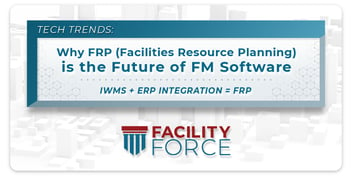Facilities Management is full of acronyms. Here’s a cheat sheet to let you know if you should be offended when someone asks if you’re a “CFM”.
| ADA | The Americans with Disabilities Act- Passed in 1990, the law prohibits discrimination against people with disabilities. ADA Standards for Accessible Design were established eliminate physical barriers and improve facility accessibility. |
| BAS | Building Automation System- A computer-controlled system that combines everything from HVAC and lighting to security alarms and AV features that exist within an office or building. |
| BIM | Building Information Modeling– Is a process for creating and managing digital information on a construction project across the project lifecycle. |
| CAD | Computer Aided Design– Is the use of computer software to aid in the creation, modification, analysis and optimization of a design. Autodesk AutoCAD is commonly used by facilities professionals. |
| CAFM | Computer Aided Facility Management– Software technology used to aid in the maintenance and management of the physical environment. CAFM is most often used for space and move management. |
| CFM | Certified Facility Manager- Is a credential established by IFMA to show ones mastery of skills and knowledge in the FM profession. |
| COBie | Construction-Operations Building Information Exchange– An international standard relating to managed asset information including space and equipment. It is closely associated with BIM approaches to design, construction, and management of built assets. |
| CMMS | Computerized Maintenance Management System– a database of facility maintenance operations. The primary role of a CMMS is tracking upkeep on high dollar items. |
| CIP | Capital Improvement Plan/Project– Is a short-range plan, usually four to ten years, which identifies capital projects and equipment purchases, provides a planning schedule and identifies options for financing the plan. |
| DBMS | Database Management System– Software that allows multiple computers to create, access and update data from a central location. |
| EAM | Enterprise Asset Management– A comprehensive system that handles all aspects of public infrastructure management. An EAM’s functionality includes HR, finance, and administrative issues. |
| ERP | Enterprise Resource Planning- A software system comprised of a single or integrated suite of applications to manage enterprise business functions, including finance, human resources, and order fulfillment. |
| FCA | Facility Condition Assessment- A detailed evaluation of a facility's condition to identify areas of the facility that need maintenance and repair investments. |
| FCI | Facility Condition Index- FCI is a standard facility management benchmark that is used to objectively assess the current and projected condition of a building asset. |
| FM | Facility Management or Facilities Management. FM Software refers to Facilities Management Software. |
| FRP | Facilities Resource Planning- Our hybrid version of an IWMS with some of the financial capabilities of an ERP. We like to refer to it as an IWMS Plus. |
| GIS | Geospatial Information System- This system allows you to view, understand, question, interpret, and visualize data in many ways that reveal relationships, patterns, and trends in the form of maps, globes, reports, and charts. |
| IoT | Internet of Things- Refers to the network of physical devices that collect and share digital data. |
| IWMS | Integrated Workplace Management System– A comprehensive software that helps businesses manage their built environment. Often called the “Jack of all trades”, an IWMS handles real estate, facility and space management, maintenance management, project management and sustainability. |
| KPI | Key Performance Indicator– Are the critical (key) indicators of progress toward an intended result. KPIs provides a focus for strategic and operational improvement, create an analytical basis for decision making and help focus attention on what matters most. |
| LCC | Life Cycle Costs– Is an approach that assesses the total cost of an asset over its life cycle including initial capital costs, maintenance costs, operating costs and the asset's residual value at the end of its life. See also TCO. |
| O&M | Operations & Maintenance- The functions, duties, and labor associated with the daily operations and normal repairs, replacement of parts and structural components, and other activities needed to preserve an asset so that it continues to provide acceptable services and achieves its expected life. |
| PM | Preventive Maintenance or Project Manager |
| ROI | Return on Investment- Is a performance measure used to evaluate the efficiency or profitability of an investment or compare the efficiency of a number of different investments. ROI tries to directly measure the amount of return on a particular investment, relative to the investment's cost. |
| SaaS | Software-as-a-Service- Sometimes referred to as “on-demand software”, is a software delivery model in which software and associated data are centrally hosted on the cloud. SaaS is typically accessed by users using a thin client via a web browser. |
| SFP | Strategic Facility Plan– Is as a 2-to-5 year facilities plan encompassing an entire portfolio of owned and/or leased space that sets strategic facility goals based on an organization's strategic objectives. |
| SLA | Service Level Agreement- Agreement between the client or customer and the service provider on performance, measurement and conditions of services delivery. Facilities Departments often have SLA’s in place with their (internal) customers and vendors. |
| TCO | Total Cost of Ownership- Includes the total of the present value of all direct, indirect, recurring, and nonrecurring costs incurred or estimated to be incurred in the design, development, production, operation, maintenance, and renewal of a facility, structure, or asset over its anticipated life span. See also LCC. |
| WO | Work Order- Are the result of tickets submitted through a ticketing system. In other words, when an issue is reported through a ticketing system, it’s a work order notifying the appropriate professionals of the problem and their need to take action to fix that problem. |




